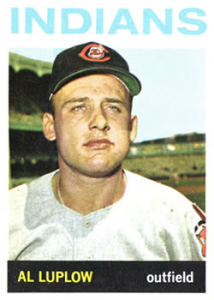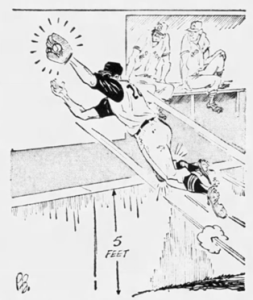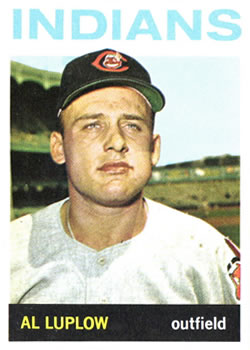June 27, 1963: Fearless Al Luplow saves the day for Cleveland with diving catch into Fenway Park bullpen
 Fenway Park’s iconic left-field wall, the Green Monster, has served as the canvas for many memorable home runs. The game-winner that Carlton Fisk waved fair in Game Six of the 1975 World Series cleared that 37-foot-tall left-field barrier, as did Bucky Dent’s go-ahead homer in the 1978 American League East tiebreaking playoff and the first major-league hit by Boston phenom Sam Horn in 1987.
Fenway Park’s iconic left-field wall, the Green Monster, has served as the canvas for many memorable home runs. The game-winner that Carlton Fisk waved fair in Game Six of the 1975 World Series cleared that 37-foot-tall left-field barrier, as did Bucky Dent’s go-ahead homer in the 1978 American League East tiebreaking playoff and the first major-league hit by Boston phenom Sam Horn in 1987.
In contrast, the lower-profile 5-foot-high wall in right-center field at Fenway, one that borders the Red Sox bullpen, is arguably best known for the home runs robbed (or almost robbed) there versus those that sailed over it.
In September 2015, Boston right fielder Mookie Betts leapt at that wall for a game-ending catch on a ball struck by the Baltimore Orioles’ Chris Davis, teetering momentarily before pulling himself back into play.1 During Game Two of the 2013 AL Championship Series, left fielder Torii Hunter of the Detroit Tigers tumbled head-over-heels after hitting the wall in a futile attempt to snare David Ortiz’s game-tying grand slam.2
Four years later, Austin Jackson, the Detroit center fielder who helped Hunter regain his bearings, pulled off what his former teammate was unable to do. Playing for the Cleveland Indians, Jackson somersaulted over that same barrier as he snared a ball hit by Boston’s Hanley Ramírez. Indians manager Terry Francona, who previously guided the Red Sox to two World Series titles, called Jackson’s catch “one of the most exciting plays I’ve seen in a long, long time.”3
On June 27, 1963, Tito Francona, father of then 4-year-old Terry, was patrolling left field at Fenway when another Cleveland outfielder, Al Luplow, made a diving catch into the Red Sox bullpen that contemporary observers called the greatest in Fenway Park history.
Cleveland was five games over .500 and in fourth place as it began a five-game series in Boston on June 24.4 The Red Sox sat one place ahead of Cleveland, five games back of the first-place New York Yankees after having just lost three of four at home to the Bronx Bombers.
His charges having taken the first four games of the series, Boston’s first-year manager, Johnny Pesky, namesake of Fenway Park’s Pesky Pole, sent 21-year-old rookie southpaw Wilbur Wood to the mound in the finale. Wood had made four starts since being called up from Triple-A Seattle, but the future four-time 20-game winner was still looking for his first win as a major leaguer.
Cleveland skipper Birdie Tebbetts, wooed away from the Milwaukee Braves in the offseason,5 countered with veteran Barry Latman, a former All-Star. A reliever the first six weeks of the season, Latman had compiled a 4.76 ERA in that role, with opposing batters hitting .292 against him, but since joining the Indians’ rotation in late May was 3-2 with a 3.56 ERA and a .219 batting average against.
Playing the percentages, Tebbetts included seven right-handed hitters in his starting lineup. His only lefty, center fielder Willie Kirkland,6 was flanked by hot-hitting Willie Tasby, batting .343, in left, and disgruntled Gene Green, a day past 30 and hitting a lowly .149, in right.7 Among those sitting out was the left-handed-hitting Luplow. A former halfback at Michigan State, Luplow was fearless, routinely running into outfield walls to track down fly balls. He often paid a price for that aggressiveness, time and again suffering injuries that kept him on the sidelines.8
A crowd of 16,192 was on hand for the afternoon contest, played in sultry weather, with the mercury touching 95.9 Of that total only 6,497 were paid, the rest “ladies and kids” admitted free of charge.10
Cleveland broke the ice in the first, plating a run on a double by Cuban second baseman Miguel de la Hoz (then known as Mike de la Hoz) and an RBI single from first baseman Joe Adcock, acquired from Milwaukee in the offseason at Tebbetts’s behest.11 The Indians tacked on another in the second on a two-out blast over the Green Monster by shortstop Jerry Kindall.
Boston cut the lead in half on a leadoff home run to left by Carl Yastrzemski in the fourth, with the score remaining 2-1 through five innings.
Back-to-back homers by rookie third baseman Max Alvis and Green leading off the Cleveland sixth spelled the end of Wood’s day. Lefty workhorse Arnold Earley came in and stopped the bleeding, leaving Cleveland up 4-1.12
In the bottom of that inning, Tebbetts inserted Luplow into left – “a defensive maneuver,” according to the Associated Press game story.13 Subbing Green out early was nothing new for Tebbetts. Though Green was errorless in the 18 games he played in the Cleveland outfield that year, his defense was shaky at times. (Eleven days earlier, his ninth-inning flub nearly handed a victory to the Washington Senators.14) In four of Green’s nine previous outfield starts, he’d been pulled for a defensive replacement in the seventh inning or earlier.
Strong through the first six innings, Latman weakened in the seventh. A two-out, two-run homer by catcher Russ Nixon brought Boston to within a run at 4-3. After singles by Earley and scrappy leadoff batter Billy Gardner, submarining reliever Ted Abernathy came into the game.15 He induced Geiger to ground out to first, ending the Red Sox threat.
Cleveland chased Earley in the eighth on a two-out single by Kindall, followed by a rare Abernathy double.16 Reliever Dick Radatz, the AL saves leader in 1962 and a baseball teammate of Luplow’s at Michigan State, intentionally walked lefty Francona, pinch-hitting for Tasby, to face de la Hoz, a righty. De la Hoz made Radatz pay, singling to left to drive in both baserunners, restoring Cleveland’s three-run margin.
Trouble found Abernathy in the bottom of the eighth. One-out singles by cleanup batter Lou Clinton and slugger Dick Stuart put runners on the corners for veteran third baseman Dick Williams, hitting an even .200 coming into the game. Williams’s one-out single off Abernathy two days earlier had ignited an eighth-inning rally that put that the second game of this series out of reach. When Abernathy delivered a high outside fastball that he later admitted was a mistake, Williams drove it to deep right-center field.17
Luplow’s description published in Sports Illustrated years later captures what happened next:
“It was in between a line drive and a fly ball,” recalls Luplow. “I kept getting closer and closer to it, and I said to myself, ‘I gotta catch this ball.’” On the dead run, about 380 feet from home plate, Luplow leapt high and speared the ball backhanded as he went sailing over the five-foot-high fence that fronts the Boston bullpen. “I felt the warning track,” he says, “so I was definitely aware of the wall. But I guess I’d just made up my mind to catch the ball. It was actually over the fence when I caught it, and I just barely touched the fence with my right knee going over.”18
Luplow instinctively rolled to keep from landing face first, but in the process spiked himself in the left knee. Momentarily out of sight, he stood and waved his gloved left hand, clutching the ball. First-base umpire Joe Paparella called Williams out.
Luplow handed the ball to Kirkland, who relayed it back to the infield in hopes of doubling up a baserunner. Both successfully tagged up, with Clinton scoring. A dejected Williams headed back to the Boston dugout, later saying of the missed home run, “All it proves is I haven’t the power of Joe Adcock.”19
Pesky made a beeline for Paparella, arguing that Luplow was off the playing field and so Williams was entitled to four bases. “It was a wonderful catch,” he argued, “but the ball was beyond the fence – and over the bull-pen when he caught it.”20 “I know I’m right” was Paparella’s reply. “He caught the ball while he was still in fair territory and he held onto it.”21
Denied the game-tying home run by Luplow, the Red Sox failed to score another run and lost 6-4. Pesky’s complaint turned into a formal protest, which the AL office denied.
The front page of the next day’s Boston Globe hailed Luplow’s heroics. “The best catch of a ball over a fence I have ever seen at Fenway Park,” wrote sportswriter Harold Kaese, who’d covered major-league baseball in Boston since the 1930s.22 He even rated it above “The Catch” – Willie Mays’ dazzling over-the-shoulder grab in Game One of the 1954 World Series. To Kaese, Luplow’s play was “more reckless, more acrobatic.”23
Expecting that Luplow wouldn’t get the recognition he deserved, Boston’s Stuart told sportswriter Will McDonough, “If Willie Mays or [former Red Sox outfielder] Jimmy Piersall had made that catch, it would go down as the greatest in history. But Al Luplow made the catch, and who’s Al Luplow – just another ball player.”24
Longtime national broadcaster Curt Gowdy, who worked the game for Boston, called Luplow’s catch the greatest he’d ever seen. In subsequent years, he often mentioned it when describing brilliant outfield grabs.25
Traded from Cleveland to the New York Mets and then on to the Pittsburgh Pirates, Luplow finished his career in 1967. That same season, first-year manager Dick Williams led the Red Sox to their first AL pennant in two decades, a campaign dubbed “The Impossible Dream.”

Acknowledgments
This article was fact-checked by Joseph Wancho and copy-edited by Len Levin.
Photo credits: Al Luplow, Trading Card Database. Cartoon from Boston Globe, June 28, 1963: 39.
Sources
In addition to the sources cited in the Notes, the author consulted the Baseball-Reference.com, Retrosheet.org, and Stathead.com websites, including box scores listed at these links:
https://www.baseball-reference.com/boxes/BOS/BOS196306270.shtml
https://www.retrosheet.org/boxesetc/1963/B06270BOS1963.htm
Notes
1 Chris Greenberg, “Watch Mookie Betts Steal a Home Run and Seal Shutout with Amazing Wall-Climbing Catch,” Boston.com, September 26, 2015, https://www.boston.com/sports/boston-red-sox/2015/09/26/watch-mookie-betts-steal-a-home-run-and-seal-shutout-with-amazing-wall-climbing-catch/.
2 Aiden Gonzalez, “Hunter’s All-Out Effort Leaves Him Banged Up, but OK,” MLB.com, October 14, 2013, https://www.mlb.com/tigers/news/torii-hunters-all-out-effort-on-david-ortizs-grand-slam-leaves-him-banged-up-but-ok/c-62915386; “Ortiz’s Grand Slam Sends Hunter Flying,” YouTube, https://www.youtube.com/watch?v=HYhpfIeO0-E, accessed July 21, 2024.
3 Jordan Bastian, “Jackson Soars over Wall to Take HR Away,” MLB.com, August 1, 2017, https://www.mlb.com/news/indians-austin-jackson-makes-amazing-catch-c245757708.
4 Originally scheduled to be a four-game series, their June 25 contest was changed to a doubleheader to make up for a late-April rainout.
5 Tebbetts left Milwaukee, a team he’d led to an 86-76 record in 1962, to replace fired Cleveland manager Mel McGaha, “because of a long-standing debt” he felt to Indians President Gabe Paul, who’d given him his first major-league managing job nearly a decade earlier. Milton Richman (United Press International), “Birdie Tebbetts Takes Over as Manager of Indian Club,” Mansfield (Ohio) News-Journal, October 6, 1962: 6.
6 Kirkland was subbing for injured rookie pitcher-turned-outfielder Vic Davalillo, who’d suffered a broken arm when hit by a pitch two weeks earlier. “Indians’ Star Injured in Win Against Tigers,” Springfield (Massachusetts) Union, June 13, 1963: 48.
7 A reserve outfielder-catcher unhappy with his lack of playing time, Green had briefly gone AWOL in early May, staying behind in Los Angeles (where he lived) when the Indians departed for a flight to Washington D.C. Suspended without pay, he reconsidered and reported to the team’s hotel on the afternoon of May 8. Green was presumably in better spirits on this day; he was getting his second start of the series. “Gene Green is AWOL at home,” Willoughby (Ohio) News-Herald, May 7, 1963: 16; “Everything’s Fine with Green – One Day’s Pay That Is,” Cleveland Plain Dealer, May 9, 1963: 69.
8 See, for example “Luplow OK,” San Francisco Examiner, July 3, 1962: 48, and Robert Dolgan, “Batting Around,” Cleveland Plain Dealer, May 13, 1963: 30.
9 Robert Dolgan, “Luplow’s Dazzling Catch Saves Victory,” Cleveland Plain Dealer, June 28, 1963: 37.
10 Larry Claflin, “Greatest Fenway Catch Robs Sox of Indian Sweep 6 to 4,” Boston Record American, June 28, 1963: 78.
11 Tebbetts was jubilant when Adcock was acquired in a November five-player deal after having spent 10 years with Milwaukee. “I admire Adcock because he’s one of the few ball players I have ever seen who never has taken a short step,” Tebbetts said the next day, adding, “He gives 100 per cent of himself all the time.” Milton Richman (UPI), “Tebbetts, Adcock’s Ex-Boss, Wanted Veteran Because He ‘Never Quit,’” Berkshire Eagle (Pittsfield, Massachusetts), November 28, 1962: 34.
12 Earley’s 53 appearances topped all AL southpaws during the 1963 season.
13 “Sensational Catch Helps Tribe Win,” St. Louis Globe-Democrat, June 28, 1963: B1.
14 Robert Dolgan, “Whitfield’s Homer Gains Sweep,” Cleveland Plain Dealer, June 17, 1963: 29.
15 Called up from Triple-A Jacksonville in May, Abernathy developed his unique delivery several years earlier in order to protect his shoulder after undergoing surgery.
16 This was the second of only three doubles that Abernathy collected during his 14-year major-league career.
17 Jay Feldman, “He Leaped a Wall to Catch the Ball, but Here’s the Catch: Who Saw It?” Sports Illustrated, October 14, 1985, https://vault.si.com/vault/1985/10/14/he-leaped-a-wall-to-catch-the-ball-but-heres-the-catch-who-saw-it.
18 “He Leaped a Wall to Catch the Ball, But Here’s the Catch: Who Saw It?”
19 Lin Raymond, “Sox-Stopping Maneuver Next Best to Miracle,” Quincy (Massachusetts) Patriot Ledger, June 28, 1963: 9.
20 Roger Birtwell, “Luplow’s Great Catch Wins for Indians,” Boston Globe, June 28, 1963: 39. Luplow later told Cleveland Plain Dealer beat writer Bob Dolgan that the ball was about three feet beyond the wall when he caught it. Several years later, Pesky admitted that Luplow’s catch was the best he’d ever seen. “I’ve seen both DiMaggios (Joe and Dom) make some great ones, but nothing better than this.” “Luplow’s Dazzling Catch Saves Victory”; “Luplow Really Flipped After Big Grab,” The Sporting News, July 2, 1966: 4.
21 “Sox-Stopping Maneuver Next Best to Miracle.”
22 Harold Kaese, “Luplow’s Catch Greatest,” Boston Globe, June 28, 1963: 1. The story appeared alongside coverage of President John F. Kennedy’s visit to Ireland, the world’s then most renowned Bay Stater visiting his ancestral home.
23 “Luplow’s Catch Greatest.”
24 Will McDonough, “’Greatest if Mays or Piersall Did It,” Boston Globe, June 28, 1963: 41.
25 Hugh Bernreuter, “‘The Catch Lives in Luplow’s Memory as Career Highlight,” Saginaw (Michigan) News, August 7, 1990: A3; Bob Dolgan, “Luplow’s Catch Ranks with Best,” Cleveland Plain Dealer, July 10, 2001: D1.
Additional Stats
Cleveland Indians 6
Boston Red Sox 4
Fenway Park
Boston, MA
Box Score + PBP:
Corrections? Additions?
If you can help us improve this game story, contact us.


